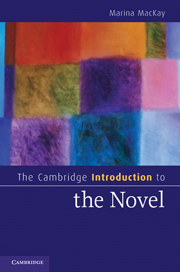Book contents
- Frontmatter
- Contents
- Acknowledgments
- About this book
- Chapter 1 Why the novel matters
- Miguel de Cervantes, Don Quixote (1605, 1615)
- Chapter 2 Origins of the novel
- Laurence Sterne, The Life and Opinions of Tristram Shandy, Gentleman (1759–67)
- Chapter 3 Narrating the novel
- James Hogg, The Private Memoirs and Confessions of a Justified Sinner (1824)
- Chapter 4 Character and the novel
- Nathaniel Hawthorne, The Scarlet Letter (1850)
- Chapter 5 Plotting the novel
- Gustave Flaubert, Madame Bovary (1857)
- Chapter 6 Setting the novel
- Charles Dickens, Bleak House (1853)
- Chapter 7 Time and history
- Virginia Woolf, To the Lighthouse (1927)
- Chapter 8 Genre and subgenre
- Graham Greene, The Ministry of Fear (1943)
- Chapter 9 Novel and anti-novel
- Thomas Pynchon, The Crying of Lot 49 (1966)
- Chapter 10 Novel, nation, community
- Salman Rushdie, Midnight's Children (1981)
- Chapter 11 Concluding
- Notes
- Glossary
- Further reading
- Index
- Cambridge Cultural Social Studies
Chapter 7 - Time and history
Published online by Cambridge University Press: 05 June 2012
- Frontmatter
- Contents
- Acknowledgments
- About this book
- Chapter 1 Why the novel matters
- Miguel de Cervantes, Don Quixote (1605, 1615)
- Chapter 2 Origins of the novel
- Laurence Sterne, The Life and Opinions of Tristram Shandy, Gentleman (1759–67)
- Chapter 3 Narrating the novel
- James Hogg, The Private Memoirs and Confessions of a Justified Sinner (1824)
- Chapter 4 Character and the novel
- Nathaniel Hawthorne, The Scarlet Letter (1850)
- Chapter 5 Plotting the novel
- Gustave Flaubert, Madame Bovary (1857)
- Chapter 6 Setting the novel
- Charles Dickens, Bleak House (1853)
- Chapter 7 Time and history
- Virginia Woolf, To the Lighthouse (1927)
- Chapter 8 Genre and subgenre
- Graham Greene, The Ministry of Fear (1943)
- Chapter 9 Novel and anti-novel
- Thomas Pynchon, The Crying of Lot 49 (1966)
- Chapter 10 Novel, nation, community
- Salman Rushdie, Midnight's Children (1981)
- Chapter 11 Concluding
- Notes
- Glossary
- Further reading
- Index
- Cambridge Cultural Social Studies
Summary
For many scholars of the early novel, a distinctively new concern with place was accompanied by an unprecedentedly extensive attention to the temporal aspect of human existence: how people change over time, how one time differs from another. Although modern readers tend to take the time component in fiction for granted, “Shakespeare … had been dead for thirty years before the word ‘anachronism’ first appeared in English.” This was how Ian Watt argued that pre-novelistic literary forms prioritized what was understood as the timeless and universal over the time-bound and contingent, a hierarchy that the novel would completely reverse; Fielding had used an almanac to ensure historical accuracy in the treatment of 1745 (the year in which Tom Jones is set), while Richardson had meticulously dated Clarissa's letters as if to say that it matters when, very precisely, they were written. The novel's concern with human life in time and history is the subject of this chapter, which begins by looking at the panoramic and long-range historical novel and novel sequence, and ends by describing some of the important transformations of narrative time undertaken by twentieth-century writers.
History and story
The eighteenth-century critic James Beattie railed against how earlier romances conflated different historical modes for the sake of an exciting story:
All facts and characters, real and fabulous; and all systems of policy and manners, the Greek, the Roman, the Feudal and the modern, are jumbled together and confounded: as if a painter should represent Julius Caesar drinking tea with Queen Elizabeth, Jupiter and Dulcinea El Toboso, and having on his head the laurel wreaths of antient Rome, a suit of Gothick armour on his shoulders, laced ruffles at his wrist, a pipe of tobacco in his mouth, and a pistol and tomahawk stuck in his belt.
- Type
- Chapter
- Information
- The Cambridge Introduction to the Novel , pp. 119 - 130Publisher: Cambridge University PressPrint publication year: 2010



